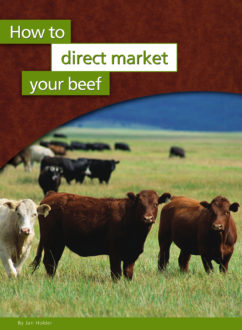INTRODUCTION

When my husband and I took over the management of the family ranch in 1992, we thought that it was going to be an idyllic life. We were going to whip the ranch into shape in a few months and then spend the next 20 years canning vegetables and writing the great American novel. We thought that if we just ran things a little more efficiently, the ranch would instantly be profitable.
It took us a couple of years to learn what was really wrong with the ranch. Sure, the place was a little rundown. The houses were in need of repair. The corrals were held together with more baling wire than wood. The land was overgrazed. But we didn’t mind hard work, so everything was going to be fine.
Then, slowly, the realization hit us. No matter how hard we worked, no matter what building we repaired or pastures we improved, the ranch was still never going to make it on its own. The beef industry had changed. Just a few generations ago, you could support your family with a herd of 25. Today, with our commodity-based cattle industry, a small cattle rancher was increasingly challenged just to make a living.
After asking around, I found that the only ranchers who were solvent were the ones who had other income. Either the wife or husband worked in town, or in our case, we had a father who was an eye doctor with deep enough pockets to subsidize the ranch. Sure, the really big ranches, the huge ranches, were making it. They could make 3 cents on a carcass and still come out okay. But they were running many thousands of animals. We had a herd of 200. How could we possibly compete?
It was clear that we couldn’t. We had to figure out how to sell our beef in a new way. We decided to try to take it from the pasture to the plate without all the middlemen in between. But after contacting an old advertising client in Phoenix who ran a chain of restaurants, I found that we could barely compete with his prices, even after cutting out all those middlemen. So, we decided that we had to make our beef different and better. Then folks would be willing to pay more for it.
To differentiate our product, we thought we could highlight our pesticide-free beef, our range-protection strategies, our “gentle” approach to raising our animals, and our acceptance of predators on the land. After all, we were considered radical, weird and strange for our tree-hugger mentality. Most other cattle ranchers thought that we were nuts. We didn’t use pesticides. We treated our cattle as gently as possible. We constantly took classes on ways to use cattle to improve the land. We didn’t kill predators. All we had to do was tell people how wonderful we were and they would flock to us in droves and buy our beef! This was going to be so easy. I really couldn’t believe that all small producers weren’t marketing their own beef.
After reading both of Joel Salatin’s books (Salad Bar Beef and Pasture Profits), we felt that between his ranch-direct program and selling in the nearest lo-cal towns, we could market all of our beef. Soon we found that we were too far out in the boonies for ranch-direct selling, the nearest tiny hamlet being 1 ½ hours away. People in the nearest sizeable town 2 ½ hours away weren’t going to pay a premium for beef. Many of the residents of those towns seem more impressed with 60-cent-a-pound hamburger than anything that we could come up with. So we decided that we were going to have to sell in Phoenix or Tucson.
We still believed in Joel Salatin’s idea of relationship marketing, but realized that our relationships were going to take a slightly different form. Even though people seemed to like the idea of ecologically sensitive ranching, not that many were willing to put their money where their mouths were. Suddenly, what looked like a huge demand turned out to be a few committed people.
We did sell to a local organic buying club (and still do), but to really make it we were going to have to hit the big cities.
Back at the ranch, we asked ourselves, “How are we going to sell beef five and six hours away?” We decided to target stores, restaurants and natural foods distributors.
Years later, it still seems too early to rest on our laurels (is there ever a time when we can rest on our laurels?), but we are very happy with the choices we have made, and sales have gone very well. In 2004, the grass-fed beef industry was estimated to be worth around $5 billion, and growing at a rate of 20 percent per year.
Our Ervin’s Grassfed Beef now sells throughout 11 western states through natural food distribution companies, as well as at farmers markets in Arizona. In addition to ground beef, ground beef patties, steaks and roasts, we now also sell pre-cooked marinated roasts and pre-cooked sliced roast beef.
Even though direct selling our beef has increased our bottom line, our company also has helped us to live the life we want, a life on a family ranch.
